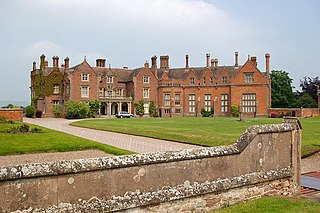
Loton Park is a country house near Alberbury, Shrewsbury in Shropshire, on the upper reaches of the River Severn. It is a Grade II* listed building. It has been the seat of the Leighton family since 1391.

Capesthorne Hall is a country house near the village of Siddington, Cheshire, England. The house and its private chapel were built in the early 18th century, replacing an earlier hall and chapel nearby. They were built to Neoclassical designs by William Smith and (probably) his son Francis. Later in the 18th century, the house was extended by the addition of an orangery and a drawing room. In the 1830s the house was remodelled by Edward Blore; the work included the addition of an extension and a frontage in Jacobean style, and joining the central block to the service wings. In about 1837 the orangery was replaced by a large conservatory designed by Joseph Paxton. In 1861 the main part of the house was virtually destroyed by fire. It was rebuilt by Anthony Salvin, who generally followed Blore's designs but made modifications to the front, rebuilt the back of the house in Jacobean style, and altered the interior. There were further alterations later in the 19th century, including remodelling of the Saloon. During the Second World War the hall was used by the Red Cross, but subsequent deterioration prompted a restoration.

Onesacre Hall is a Grade II* Listed building situated in the rural outskirts of the City of Sheffield in South Yorkshire, England. The hall is located on Green Lane in the small hamlet of Onesacre in the suburb of Oughtibridge, 5 miles (8.5 km) north west of the city centre.
Lymm Hall is a moated country house in the village suburb of Lymm in Warrington, Cheshire, England. It is recorded in the National Heritage List for England as a designated Grade II* listed building.

Ince Blundell Hall is a former country house near the village of Ince Blundell, in the Metropolitan Borough of Sefton, Merseyside, England. It was built between 1720 and 1750 for Robert Blundell, the lord of the manor, and was designed by Henry Sephton, a local mason-architect. Robert's son, Henry, was a collector of paintings and antiquities, and he built impressive structures in the grounds of the hall in which to house them. In the 19th century the estate passed to the Weld family. Thomas Weld Blundell modernised and expanded the house, and built an adjoining chapel. In the 1960s the house and estate were sold again, and have since been run as a nursing home by the Canonesses of St. Augustine of the Mercy of Jesus.
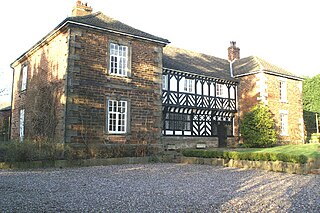
Mawdesley Hall is a country manor in Hall Lane, Mawdesley, Chorley, Lancashire, England. It consists of a central hall with two cross-wings. The central hall was built in the 17th century, its lower storey being timber-framed and its upper floor plastered and painted to resemble timber-framing. The cross-wings were added in the late 18th or early 19th century. The west wing is in sandstone, and the east wing is in brick with stone dressings. The hall is recorded in the National Heritage List for England as a designated Grade I listed building.

Nun Monkton Priory is a historic house in Nun Monkton, a village in North Yorkshire, in England.

Grimethorpe Hall is a manor house in Grimethorpe, South Yorkshire, England. Built circa 1670 for Robert Seaton, it is thought to be in the style of York architect Robert Trollope. Around 1800 the hall passed to John Farrar Crookes of Tunbridge Wells. It was last used as a house in the 1960s and afterwards was purchased by the National Coal Board. The National Coal Board applied to demolish it in 1981 but, after a campaign by the Ancient Monuments Society, this was unsuccessful. The structure received statutory protection as a grade II* listed building in 1985.

High Hall is a historic building in Appletreewick, a village in North Yorkshire in England.
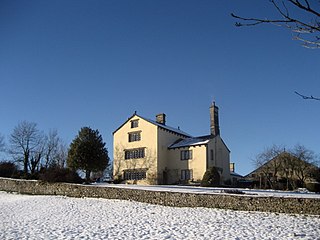
Bank Newton Hall is a historic building in Bank Newton, a village in North Yorkshire, in England.

Mewith Head Hall is a historic building in Bentham, North Yorkshire, a town in England.
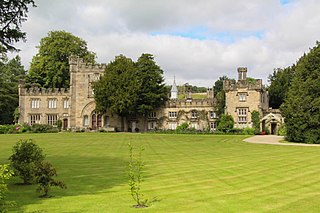
Bolton Abbey Hall is a historic building in Bolton Abbey, a village in North Yorkshire, in England.

The Punch Bowl is a historic pub in Burton in Lonsdale, a village in North Yorkshire, in England.
Carleton-in-Craven is a civil parish in the Craven district of North Yorkshire, England. It contains 27 listed buildings that are recorded in the National Heritage List for England. Of these, one is listed at Grade II*, the middle of the three grades, and the others are at Grade II, the lowest grade. The parish contains the village of Carleton-in-Craven and the surrounding countryside. Most of the listed buildings are houses, cottages and associated structures, farmhouses and farm buildings. The other listed buildings include a church and an inscription on the churchyard wall, a public house, a group of former almshouses, a school converted into a village hall, a former cotton mill, a cross base, a milestone, and four parish boundary stones.

Yew Tree House is a historic building in Cawood, a village in North Yorkshire, in England.
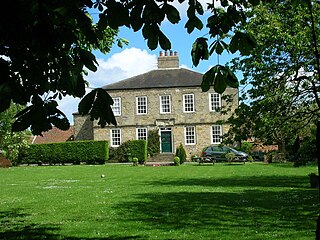
Killerby Old Hall is a historic building in Cayton, a village in North Yorkshire, in England.
Garth Cottage is a historic building in Coverham, a village in North Yorkshire, in England.
Long Croft is a historic house in Cowling, a village in North Yorkshire, in England.

The Old Hall is a historic building in Coxwold, a village in North Yorkshire, in England.
Lazenby Hall is a historic building near Danby Wiske, a village in North Yorkshire, in England.















